Pobeda: Elusive and Unrepentant, Part 2
Day 1After breakfast, we took a slow and steady several hours to inspect each other’s gear, count GU packets, and weigh the pros and cons of couscous. After a few hours, in hot sunshine, we shouldered our monster packs and headed up the moraine. Soon, we traversed onto the ice of the Zvezdochka (Starry) Glacier. While beautiful, it was bright, hot, slushy and a maze of seracs and narrow river slots. Icy blue pools fed spectacular waterfalls. As we neared Camp 1, snow bridges became slushier and sketchier and we roped up. Just as we started to wonder where the Dutch tents would be, Bob led over a small rise and whooped out in joy…two beautiful tents were pitched in a broad, safe site just shy of camp one proper. We divvied up tasks and got to work re-anchoring tents and sorting gear. I fetched water from a nearby crevasse pond…we would use every trick in the book to save fuel.Day 2We wanted to get up through the serac band before sunrise, but when our alarm went of at 4 it was snowing and nasty out. We gladly took the extra hour or so of sleep before we brewed up, got dressed and marched up the glacier. Soon we could see an Iranian group working through the difficult sections above, and it was quite obvious why this portion of the route to Dikiy Pass was feared: a narrow and rotten gully was our only access to vertical/overhanging seracs fixed with lines. We romped up the gully as fast as we could, but the heat of the day was already softening things up and making the going tough. At the base of the seracs proper, Bob encountered a tricky overhang which took a few creative ideas and a ton of swearing to overcome. I ended up opting for my hands and knees on a dicey narrow ledge that we’d fixed with an additional ice screw. Just above, I popped through a snow bridge (protected by fixed line of course, but annoying nonetheless). The temperature was absurd. I’d say it felt like the upper 80s to 90s. All this with a monster pack and the inability to swap out 8000m boots for flip flops. After a mid day snack, I took the lead of the rope team as we entered the broad and gentle valley to Dikiy Pass. As we rounded a corner that gave our first views of camp 2 above, I saw a few climbers above moving slowly. Soon we reached two Iranians who were dealing with exhaustion. We didn’t feel much better and continued the last few meters to camp. A lone Russian wearing ski goggles and suffering from extraordinary sunburn plodded down at a snails pace. I stopped to say hi and learned that one climber had died on the summit ridge. No more details were exchanged as he continued to lumber down towards the glacier below. That evening, as we watched from our spectacular site we watched in awe as the entire Russian and Ukrainian contingents descended. They looked like hell. No fewer than twenty men, some collapsing every few meters slowly made their way down the ridge. It was an exodus. Soon, we were quite alone. The mountain felt different.Day 3We awoke to good conditions. The route to camp 3 looked beautiful and exciting, but once we wove out of camp 2 and got onto the lower buttress, things became challenging in hurry. The snow was deep and soft, and the hordes of climbers who had descended the previous day had turned the bootrack into sloppy ruts. The going got rougher when the wind and snow began to pick up. I donned my outerwear and our team regrouped to rope up at a small crevasse. Just a few meters later, things really deteriorated. In horizontal snow, we yelled over the wind for a bit before deciding to chop a platform and make camp. With the three of us working together, we stomped and shoveled a generous site, set up the tent and jumped in.___________________________________________________________________________I felt a punch to my chest and lurched upright in the darkness. Bob was trying to wake me but I was already beyond alert. The roar of the wind started so suddenly, Bob had thought an avalanche was barreling down on us and was bracing for impact. So much for the weather. We spent the next five or so hours til dawn getting hammered by wind and spindrift out of the west so violent that it filled our vestibule with snow and was starting to crush us. Periodically I sat up to punch the consolidating snow to clear some space for sleeping. By the time the morning came, we knew we were pinned down for the day. Bob, always a team player, got out and started shoveling first. Our tent had been buried to the brim on the uphill side and our guy lines were coated in rime ice. We learned that those above us at 6400m had an ordeal in the night but were okay.Day 4Later in the morning, things cleared in a most spectacular fashion. Below, a sea of snowcapped peaks stretched in all directions. The magic of the Central Tien Shan was alive. All of our stuff luckily got dry and we spent the day resting and discussing the weather. What would we do? Later in the afternoon the winds picked up. Soon, we heard shouting voices and exited to see two figures in the whiteout probing for crevasses below. We briefly chatted with the two Russians as they came by, asking about the whereabouts of camp 3 as they slowly postholed higher. Later that evening, we met Juho as he rapidly descended to camp 2, his summit bid over.Day 5After a string of increasingly alarming weather forecasts for the coming days, we decided to pack up and descend to camp 2. At least camp 2 was in a safe (we weren’t so convinced that our spot on the buttress was out of avalanche danger) and comfortable location. After a short descent to camp 2, we again were able to stretch out, dry our clothing and sleeping bags and enjoy the mountain a bit. But the forecast continued to deteriorate. Now, winds were expected to be 90 mph for a couple days, and the pattern after the major wind storm seemed unsettled, with a substantial snowfall forecasted afterwards. Did we have enough food to sit out the weather and still make a summit attempt? Even in the best of circumstances, we’d have no margin for extra days as our reserves of food and fuel would be depleted by a 4-5 day wait. After much deliberation, we settled on returning to base camp in the morning. And that’s when the fun began. I tore into scrambled eggs, sliced cheese, blueberry granola and pasta. No sense lugging extra weight back down the mountain. Plus, in the previous couple days we’d been purposefully starving ourselves to keep as much extra food as possible. In the evening, a huge serac ripped off the summit ridge and produced undoubtedly the largest avalanche I’ve witnessed. Though we were miles away and several thousand feet higher than where it landed, the powder blast steadily marched up valley and swept over us and into the Dikiy Glacier valley. We were now quite alone on the mountain, as only the Russian pair were above us. I rested well knowing our mission was clearer though we still needed to return through some tricky terrain to base camp.Day 6We woke up to another spectacular day. With our systems and teamwork now dialed, we packed up and roped up for the glacier below. The route was spectacular in early morning light and the firm snow made for enjoyable cramponing. Soon we reached the top of the fixed lines as a few climbers ascended on their own summit bids. The glorious weather and the presence of others pushing higher made us openly question our decision. We remarked that while we certainly didn’t want anyone to get into trouble, we almost wanted the weather to get nasty to justify our bailing in such perfect conditions. By noon I reached the comfort of base camp, now more of a deserted tent city. Relaxed and happy, my journey into the unknown was over.AftermathAs predicted, the storm rolled through. Winds first started to roll over the ridge, then things got nasty in base camp. People were holding the dining tent down for dear life. Some tents were blown away in base camp. Reports from the Russian duo, now in a snow hole at 6900 were of 135 kph winds and being pinned down.Pobeda: Route overview and considerations above our high point Camp 3 (5800m)Simple, but somewhat avalanche-prone slopes from Dikiy Pass. There was a huge snow cave there, which could be used to escape extreme weather. But in the Russian/Ukrainian exodus following their assault, this had essentially been turned into a field hospital. We let our minds run wild as there were reports of trash, blood, vomit and discarded dexamethasone needles.Camp 4 (6400m) Looked like fun and moderate climbing up the first rock band and in and out of couloirs to this airy perch. You know you’re getting close when you see the dead guy from last year. While somewhat sheltered, there’s space for just three tents. No snow cave option. Iranians were stuck here for six days. A tent collapsed here during our eventful night at 5600m.Camp 5 (6700 or 6900m)Sounded like there were snow cave options in either of these locations. West Pobeda (6900m) would be the only option for a one-day summit push that skipped the 7100m obelisk camp. Despite the simple climbing above 6400m, they both sounded like death traps. Go up there, get in a snow hole, and pray that the weather lets you get down.Summit Ridge This thing simply gets hammered with insane winds, usually out of the west. Every. Day. During my several week stay here, I observed just two days that would have been good to be up there. Let’s say an average day is 40-50 mile per hour winds (gusts can knock you over!). At 23,000 ft, air temperature in the vicinity of 0 °F. During the bad times the ridge is obscured by a giant cloud and snow plume. Winds were as high as 90 miles per hour (72 is a hurricane). On several occasions, we observed wind driven over a kilometer off the summit into western China.
Return of the Snow Leopard: The Film
Here's the short movie I filmed and edited as it happened. Enjoy!HariReturn of the Snow Leopard from Hari Mix on Vimeo.
Pobeda: Elusive and Unrepentant, Part 1
“It is better to return to Pobeda ten times than to not return once” –Gleb Sokolov
Fifty-nine mountains are higher. Plenty are steeper. But few are harder. Despite it’s relatively moderate climbing, Peak Pobeda routinely turns back—and kills—those who don’t take it seriously.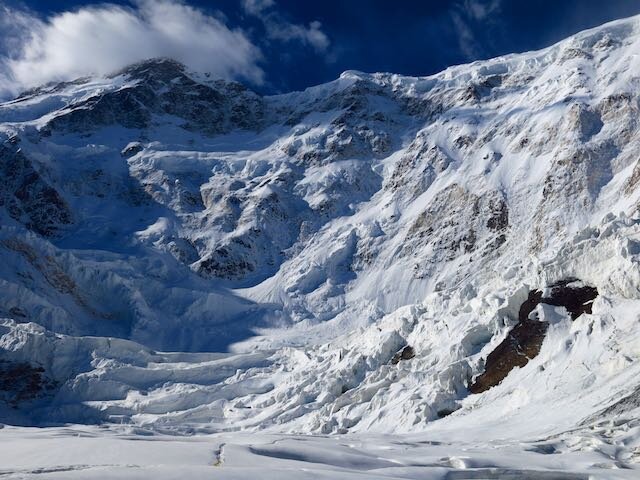 Following several weeks of acclimatizing and strategizing, Pobeda casually thwarted our strong and competent team over a vertical mile below its summit. Here is the story:Day 0For days, base camp had been abuzz. Prior to potential summit windows, these places become infested with gossip, anxieties, impressive gear spreading, and endless conversations about the weather.Thirty or so Russians and Ukrainians, ascending in what can only be described as a military siege, were nearing the summit. Excitement was in the air, but with the short climbing season nearing its close, the rest of us sized up the others and scrambled to make arrangements. It was a veritable hodge-podge of mostly small teams.My own thinking and organization began to crystalize around a few core concepts: 1) Don’t do anything stupid, 2) I knew that despite my perfect health and strong climbing below 6000m, I had limited acclimatization. I was able to climb from base camp to Khan Tengri’s Camp 3 (5900m) in seven comfortable hours, but I only had one night there and two at 5600m. I needed a slower, more conventional ascent on Pobeda in order to acclimatize on the mountain. No sprinting to a snow cave at 6900m in just a couple days, 3) I needed the security of extra food, fuel, and strong shelter. This was shaping up to be the biggest pack I’d ever lugged…about two weeks of food and fuel. And my clothing system was outrageous—as warm as gear is made.All three factors drew me to joining an American couple living in Canada. Bob, a contractor and former Alaska Range guide, and Katherine, a philosophy professor with a calm, determined mind, had tons of big mountain experience, and I could tell that by partnering with experienced Americans, we had similar philosophies, risk tolerances (hell yes we were roping up on the lower glacier) and strategies for the summit. We got along well personally, which we knew would be vital for the inevitable tentbound storm days. We would try as hard as we could within our safety bounds. Team America was born.
Following several weeks of acclimatizing and strategizing, Pobeda casually thwarted our strong and competent team over a vertical mile below its summit. Here is the story:Day 0For days, base camp had been abuzz. Prior to potential summit windows, these places become infested with gossip, anxieties, impressive gear spreading, and endless conversations about the weather.Thirty or so Russians and Ukrainians, ascending in what can only be described as a military siege, were nearing the summit. Excitement was in the air, but with the short climbing season nearing its close, the rest of us sized up the others and scrambled to make arrangements. It was a veritable hodge-podge of mostly small teams.My own thinking and organization began to crystalize around a few core concepts: 1) Don’t do anything stupid, 2) I knew that despite my perfect health and strong climbing below 6000m, I had limited acclimatization. I was able to climb from base camp to Khan Tengri’s Camp 3 (5900m) in seven comfortable hours, but I only had one night there and two at 5600m. I needed a slower, more conventional ascent on Pobeda in order to acclimatize on the mountain. No sprinting to a snow cave at 6900m in just a couple days, 3) I needed the security of extra food, fuel, and strong shelter. This was shaping up to be the biggest pack I’d ever lugged…about two weeks of food and fuel. And my clothing system was outrageous—as warm as gear is made.All three factors drew me to joining an American couple living in Canada. Bob, a contractor and former Alaska Range guide, and Katherine, a philosophy professor with a calm, determined mind, had tons of big mountain experience, and I could tell that by partnering with experienced Americans, we had similar philosophies, risk tolerances (hell yes we were roping up on the lower glacier) and strategies for the summit. We got along well personally, which we knew would be vital for the inevitable tentbound storm days. We would try as hard as we could within our safety bounds. Team America was born.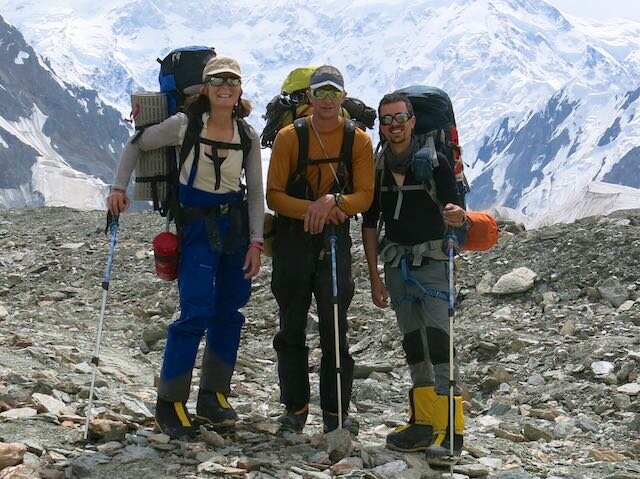 One hitch…we didn’t have the ideal shelter solution. I had a two man single-wall tent and they had a double wall, but essentially a one-man tent. We needed to distribute weight better: one tent, one stove. I set off on a multi-day and impressive, if I dare say so myself, diplomatic mission. Within a day, I brokered a straight up trade with a Dutch trio for our pie in the sky dream tent: a Mountain Hardwear Trango 3.1. Double wall. Strong as hell. And downright palatial. My single wall was perfect for their objective.____________________________________________________________________More writing coming as I get more juice. I am in base camp waiting out the storm. It is bad, even down here. Hopefully heli to Bishkek tomorrow!Hari
One hitch…we didn’t have the ideal shelter solution. I had a two man single-wall tent and they had a double wall, but essentially a one-man tent. We needed to distribute weight better: one tent, one stove. I set off on a multi-day and impressive, if I dare say so myself, diplomatic mission. Within a day, I brokered a straight up trade with a Dutch trio for our pie in the sky dream tent: a Mountain Hardwear Trango 3.1. Double wall. Strong as hell. And downright palatial. My single wall was perfect for their objective.____________________________________________________________________More writing coming as I get more juice. I am in base camp waiting out the storm. It is bad, even down here. Hopefully heli to Bishkek tomorrow!Hari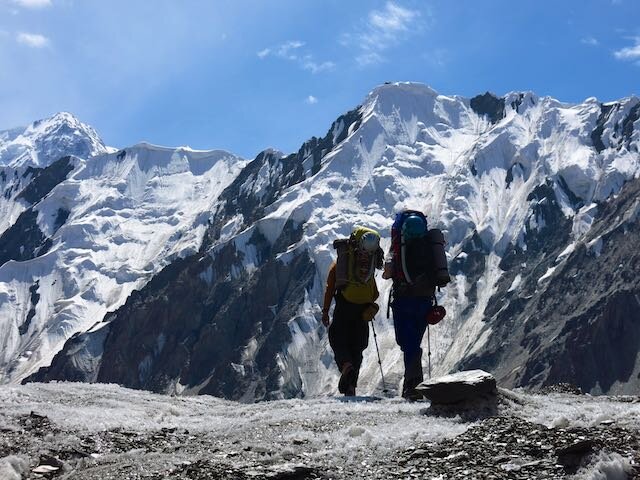

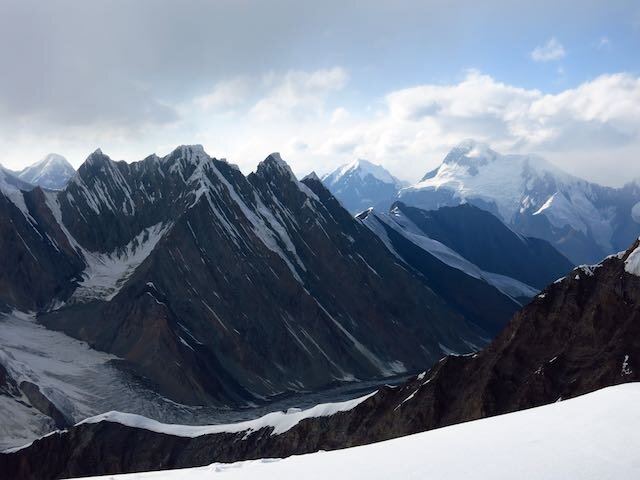

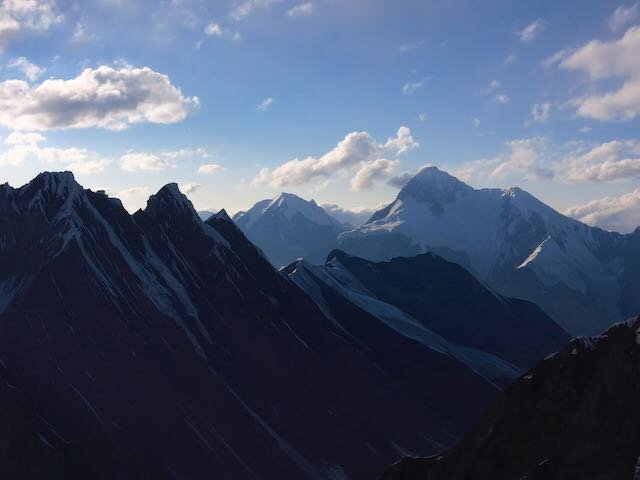
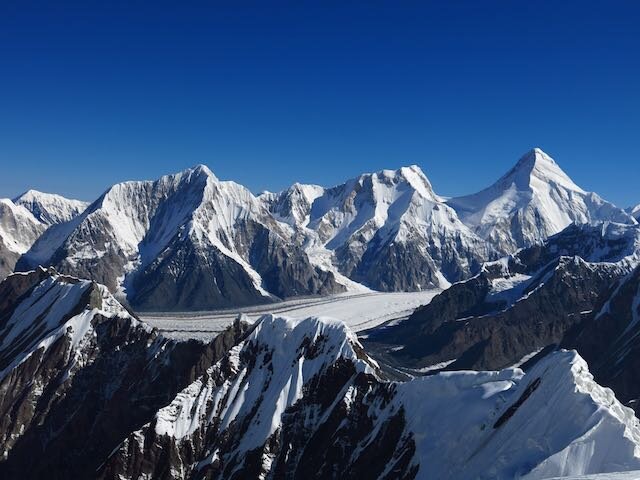
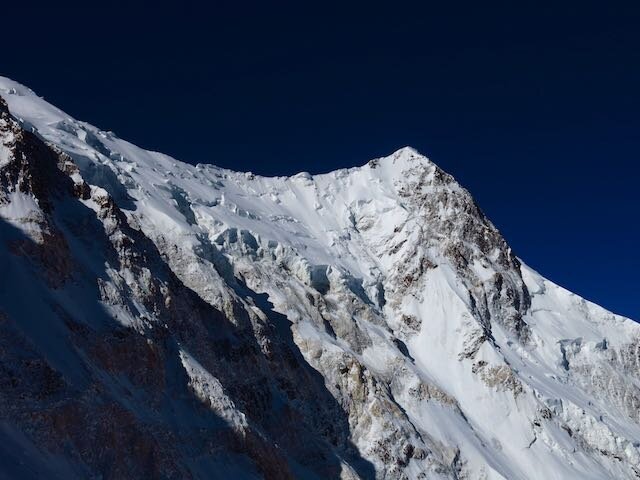
Summer 2012 Wrapup and Photos
I made it back to the US without much of a hitch, but almost immediately went right back out into the field. So at last, here are full photo galleries and trip reports from Mongolia, Kyrgyzstan and Tajikistan. I'll start with photos and narratives from the Gobi and the Altai:Very Best of Mongolia After paleoclimate research in Mongolia, I headed to the Snow Leopard Peaks of the Pamir. First up was Lenin Peak in southern Kyrgyzstan.Complete photos from Kyrgyzstan:Very Best of Kyrgyzstan For narratives of my experience there, see:BishkekInnocence Lost on LeninFrom Lenin, I crossed over Karamyk Pass into Tajikistan.Complete Photos:Very Best of Tajikistan And trip reports:TajikistanMoskvin Glacier and AcclimatizationKorzhenevskaya in a Day SoloPik Kommunizma: Too Heavy
Welcome to the Blog!
Hey everyone, I’m Hari and welcome to my blog. Here you’ll find posts ranging from trip reports, photos and video to thoughts on my style, technique and spirit of adventure in the high alpine. The blog will also feature live coverage from my expeditions, including summer 2012’s monster trip to Asia for paleoclimate research in Mongolia followed by a triple-header expedition to the three highest peaks in the Pamir of central Asia!